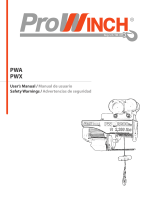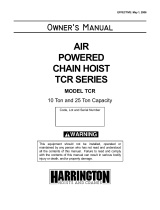
Maintenance and Inspections:
A designated person must verify that the device complies with all regulations, codes, and standards that
apply to “Under-the-Hook Lifting Devices” in the location where the tongs are used. The person(s)
designated to conduct inspections must do so before
the tongs are used for the first time, and EACH time
the hook is installed for use.
Inspections:
The end-user is responsible for performing inspections as recommended in ASME B30.20,
which categorizes examinations based on regularity of performance. Highlights of the recommended
inspection procedures appear below. However, the full procedures as explained in the published
standard must be followed.
DO NOT use tongs that are structurally damaged. Such damage might include bent,
warped, cracked or otherwise deformed link arms, clamping arms, or shackle (see FIG. 1 on p.6).
Restore the tongs to normal operating condition BEFORE using them again.
Inspections Before & During EVERY lift
: visual examination must be performed by the operator prior to
AND during each lift. In particular, the operator should inspect for:
1. Debris on the load surfaces; AND
2. Condition and operation of the controls.
Frequent Inspections
: the specific meaning of “frequent” varies from daily to monthly depending on the
service classification (normal, heavy, severe, and special/infrequent) of the tongs. Definitions of the
service classifications appear in ASME B30.20. The operator or other designated person(s) should
visually inspect the tongs for:
1. Deformation, cracking, or excessive wear of any part of the tongs;
2. Operating mechanisms for conditions that interfere with proper function; AND/OR
3. Loose or missing fasteners, stops or nameplates.
Periodic Inspections
: complete visual inspections performed AND recorded by a qualified person. The
inspection should specifically look for:
1. Loose bolts or fasteners;
2. Excessive wear of friction pads, linkages, and other mechanical parts; AND/OR
3. Excessive wear at the points where the tongs connect to the hoist hook, and load support
clevises or pins.
Maintenance: the end-user must implement a maintenance program to ensure the proper function and
safety of the tongs. A qualified person may establish a program that is used in preference to the
maintenance procedures described below. However, if you apply the procedure below, complete EVERY
step each time
maintenance is performed.
ONLY qualified persons may perform maintenance on the tongs. A qualified person is
someone “who, by possession of a recognized degree in an applicable field or certificate of professional
training, and experience, has successfully demonstrated the ability to solve or resolve problems relating
to the subject matter and work.” See ASME B30.20-0.2-2003.
Step 1
: All sources of power must be disconnected, locked out and tagged, “Out of Service.”
Step 2
: Disconnect the tongs from the hoist hook, and tag them as, “Out of Service.”
Step 3
: Perform all adjustments identified as necessary during any inspection (every lift, frequent, or
periodic). Refer to ASME B30.20 for recommended inspection procedures.
Step 4
: If other conditions exist which require new or replacement parts to repair, contact Vestil to order
replacements. Deformity, corrosion, rusting, or excessive wear of fasteners and/or the link arm(s),
clamping arm(s), and/or shackle warrants immediate replacement of the affected part(s).
The reader should understand the significant difference between “Adjustments [and]
repairs,” and modifications. An adjustment or repair refers to a simple correction that restores the tongs
to normal operating condition, such as tightening loose fasteners, or removing debris. A modification is a
(Continued on page 12)
- 11 -














